transmission Alfa Romeo Giulietta 2018 Owner's Manual
[x] Cancel search | Manufacturer: ALFA ROMEO, Model Year: 2018, Model line: Giulietta, Model: Alfa Romeo Giulietta 2018Pages: 216, PDF Size: 3.39 MB
Page 49 of 216

Warning lights on
panelWhat it means What to do
ENGINE COOLANT TEMPERATURE TOO HIGH
The warning light switches on when the ignition key is
turned to MAR, but it should switch off after a few
seconds. The warning light turns on when the engine is
overheated.
The display shows the dedicated message.In normal driving conditions: stop the car, switch off the
engine and check that the water level in the reservoir is
not below the MIN mark. In this case, wait for the engine to
cool down, then slowly and carefully open the cap, top up
with coolant and check that the level is between the MIN
and MAX marks on the reservoir itself. Also check visually
for any fluid leaks. Should the warning light turn on again
at the next start-up, contact an Alfa Romeo Dealership.
If the vehicle is used under demanding conditions: (e.g. in
high-performance driving): slow down and, if the warning
light stays on, stop the vehicle. Wait for 2 or 3 minutes
with the engine running and slightly accelerated to further
favour the coolant circulation. Then stop the engine. Check
that the coolant level is correct as described above.
IMPORTANT Over demanding routes, it is advisable to
keep the engine on and slightly accelerated for a few
minutes before switching it off.
ALFA TCT FAILURE
(for versions/markets, where provided)
The warning light switches on when the ignition key is
turned to MAR, but it should switch off after a few
seconds.
The warning light flashes (together with a message in the
display and an acoustic signal) to indicate that the gearbox
is faulty.
The warning light can switch on even in the case of
transmission overheating, after a particularly demanding
use. In this case an engine performance limitation is
carried out.Contact an Alfa Romeo Dealership as soon as possible.
If it is necessary to start the engine with a transmission
failure, follow the procedure described in the "Alfa TCT"
paragraph, in chapter "Starting and driving".
SPEED LIMIT EXCEEDED
(for versions/markets, where provided)
The warning light switches on when the car exceeds the
speed limit value set in the Setup Menu (e.g. 120 km/h).
On some versions a message is shown along with a symbol
on the display, and an acoustic signal is emitted.
47
Page 85 of 216

Let’s get to the core of the vehicle: seeing how you can exploit all
of its potential to the full.
We’ll look at how to drive it safely in any situation, so that it can be
a welcome companion, with our comfort and our wallets in mind.
STARTING AND DRIVING
STARTING THE ENGINE . .........................84
WHEN PARKED................................85
TWIN CLUTCH TRANSMISSION......................85
MANUAL TRANSMISSION . . .......................88
START&STOP SYSTEM...........................89
CRUISE CONTROL ..............................91
PARKING SENSORS.............................92
TOWING TRAILERS.............................94
REFUELLING THE CAR...........................94
Page 87 of 216
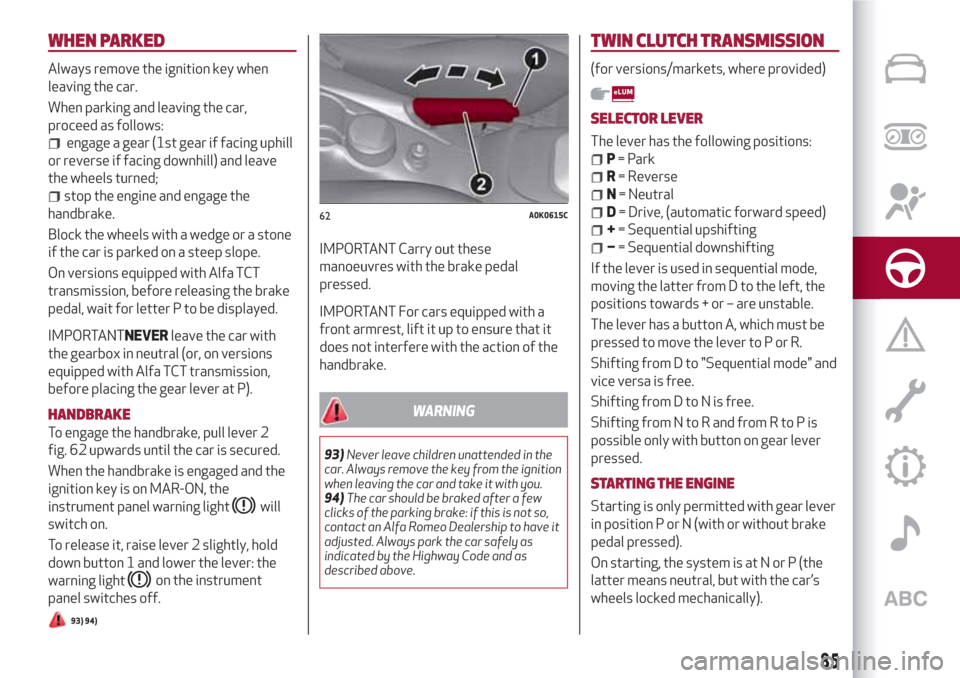
WHEN PARKED
Always remove the ignition key when
leaving the car.
When parking and leaving the car,
proceed as follows:
engage a gear (1st gear if facing uphill
or reverse if facing downhill) and leave
the wheels turned;
stop the engine and engage the
handbrake.
Block the wheels with a wedge or a stone
if the car is parked on a steep slope.
On versions equipped with Alfa TCT
transmission, before releasing the brake
pedal, wait for letter P to be displayed.
IMPORTANTNEVERleave the car with
the gearbox in neutral (or, on versions
equipped with Alfa TCT transmission,
before placing the gear lever at P).
HANDBRAKE
To engage the handbrake, pull lever 2
fig. 62 upwards until the car is secured.
When the handbrake is engaged and the
ignition key is on MAR-ON, the
instrument panel warning light
will
switch on.
To release it, raise lever 2 slightly, hold
down button 1 and lower the lever: the
warning light
on the instrument
panel switches off.
93) 94)
IMPORTANT Carry out these
manoeuvres with the brake pedal
pressed.
IMPORTANT For cars equipped with a
front armrest, lift it up to ensure that it
does not interfere with the action of the
handbrake.
WARNING
93)Never leave children unattended in the
car. Always remove the key from the ignition
when leaving the car and take it with you.
94)The car should be braked after a few
clicks of the parking brake: if this is not so,
contact an Alfa Romeo Dealership to have it
adjusted. Always park the car safely as
indicated by the Highway Code and as
described above.
TWIN CLUTCH TRANSMISSION
(for versions/markets, where provided)
SELECTOR LEVER
The lever has the following positions:
P= Park
R= Reverse
N= Neutral
D= Drive, (automatic forward speed)
+= Sequential upshifting
−= Sequential downshifting
If the lever is used in sequential mode,
moving the latter from D to the left, the
positions towards + or – are unstable.
The lever has a button A, which must be
pressed to move the lever to P or R.
Shifting from D to "Sequential mode" and
vice versa is free.
Shifting from D to N is free.
Shifting from N to R and from R to P is
possible only with button on gear lever
pressed.
STARTING THE ENGINE
Starting is only permitted with gear lever
in position P or N (with or without brake
pedal pressed).
On starting, the system is at N or P (the
latter means neutral, but with the car’s
wheels locked mechanically).
62A0K0615C
85
Page 88 of 216
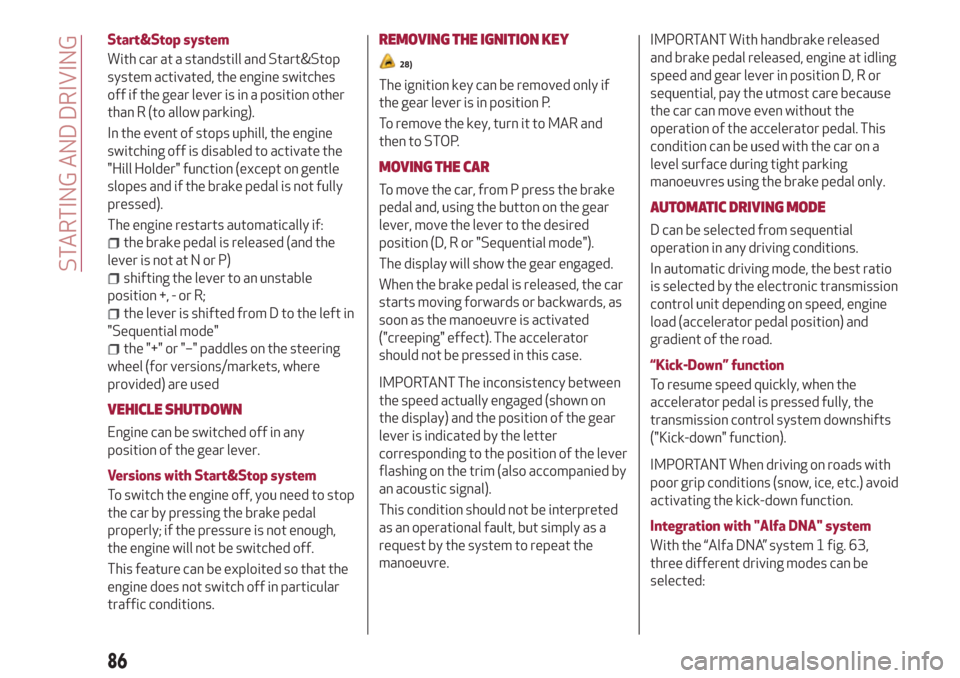
Start&Stop system
With car at a standstill and Start&Stop
system activated, the engine switches
off if the gear lever is in a position other
than R (to allow parking).
In the event of stops uphill, the engine
switching off is disabled to activate the
"Hill Holder" function (except on gentle
slopes and if the brake pedal is not fully
pressed).
The engine restarts automatically if:
the brake pedal is released (and the
lever is not at N or P)
shifting the lever to an unstable
position +, - or R;
the lever is shifted from D to the left in
"Sequential mode"
the "+" or "–" paddles on the steering
wheel (for versions/markets, where
provided) are used
VEHICLE SHUTDOWN
Engine can be switched off in any
position of the gear lever.
Versions with Start&Stop system
To switch the engine off, you need to stop
the car by pressing the brake pedal
properly; if the pressure is not enough,
the engine will not be switched off.
This feature can be exploited so that the
engine does not switch off in particular
traffic conditions.
REMOVING THE IGNITION KEY
28)
The ignition key can be removed only if
the gear lever is in position P.
To remove the key, turn it to MAR and
then to STOP.
MOVING THE CAR
To move the car, from P press the brake
pedal and, using the button on the gear
lever, move the lever to the desired
position (D, R or "Sequential mode").
The display will show the gear engaged.
When the brake pedal is released, the car
starts moving forwards or backwards, as
soon as the manoeuvre is activated
("creeping" effect). The accelerator
should not be pressed in this case.
IMPORTANT The inconsistency between
the speed actually engaged (shown on
the display) and the position of the gear
lever is indicated by the letter
corresponding to the position of the lever
flashing on the trim (also accompanied by
an acoustic signal).
This condition should not be interpreted
as an operational fault, but simply as a
request by the system to repeat the
manoeuvre.
IMPORTANT With handbrake released
and brake pedal released, engine at idling
speed and gear lever in position D, R or
sequential, pay the utmost care because
the car can move even without the
operation of the accelerator pedal. This
condition can be used with the car on a
level surface during tight parking
manoeuvres using the brake pedal only.
AUTOMATIC DRIVING MODE
D can be selected from sequential
operation in any driving conditions.
In automatic driving mode, the best ratio
is selected by the electronic transmission
control unit depending on speed, engine
load (accelerator pedal position) and
gradient of the road.
“Kick-Down” function
To resume speed quickly, when the
accelerator pedal is pressed fully, the
transmission control system downshifts
("Kick-down" function).
IMPORTANT When driving on roads with
poor grip conditions (snow, ice, etc.) avoid
activating the kick-down function.
Integration with "Alfa DNA" system
With the “Alfa DNA” system 1 fig. 63,
three different driving modes can be
selected:
86
STARTING AND DRIVING
Page 89 of 216
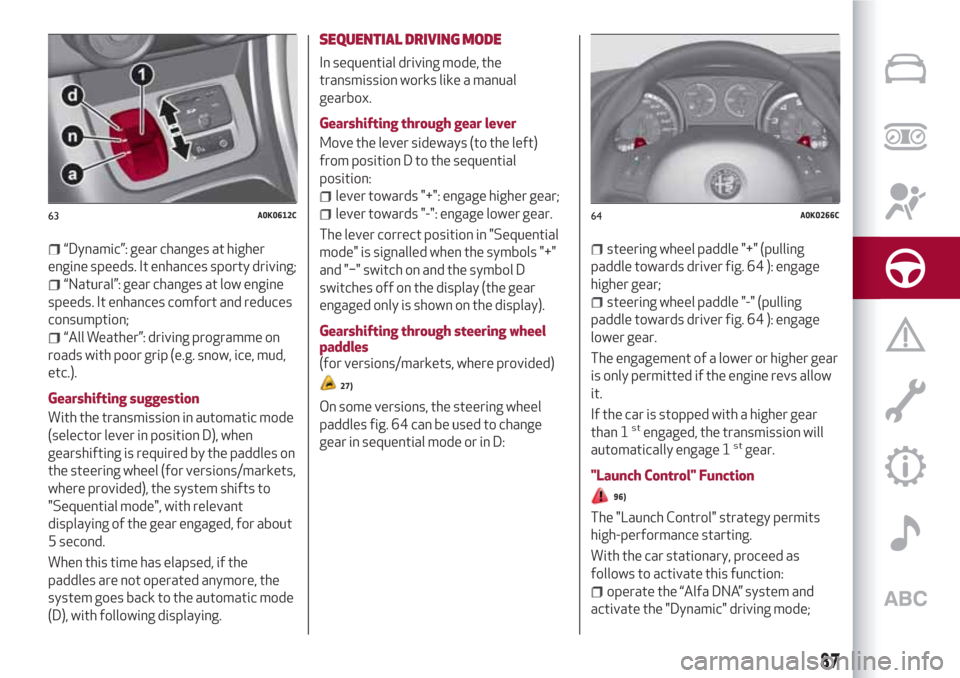
“Dynamic”: gear changes at higher
engine speeds. It enhances sporty driving;
“Natural”: gear changes at low engine
speeds. It enhances comfort and reduces
consumption;
“All Weather”: driving programme on
roads with poor grip (e.g. snow, ice, mud,
etc.).
Gearshifting suggestion
With the transmission in automatic mode
(selector lever in position D), when
gearshifting is required by the paddles on
the steering wheel (for versions/markets,
where provided), the system shifts to
"Sequential mode", with relevant
displaying of the gear engaged, for about
5 second.
When this time has elapsed, if the
paddles are not operated anymore, the
system goes back to the automatic mode
(D), with following displaying.
SEQUENTIAL DRIVING MODE
In sequential driving mode, the
transmission works like a manual
gearbox.
Gearshifting through gear lever
Move the lever sideways (to the left)
from position D to the sequential
position:
lever towards "+": engage higher gear;
lever towards "-": engage lower gear.
The lever correct position in "Sequential
mode" is signalled when the symbols "+"
and "−" switch on and the symbol D
switches off on the display (the gear
engaged only is shown on the display).
Gearshifting through steering wheel
paddles
(for versions/markets, where provided)
27)
On some versions, the steering wheel
paddles fig. 64 can be used to change
gear in sequential mode or in D:
steering wheel paddle "+" (pulling
paddle towards driver fig. 64 ): engage
higher gear;
steering wheel paddle "-" (pulling
paddle towards driver fig. 64 ): engage
lower gear.
The engagement of a lower or higher gear
is only permitted if the engine revs allow
it.
If the car is stopped with a higher gear
than 1
stengaged, the transmission will
automatically engage 1stgear.
"Launch Control" Function
96)
The "Launch Control" strategy permits
high-performance starting.
With the car stationary, proceed as
follows to activate this function:
operate the “Alfa DNA” system and
activate the "Dynamic" driving mode;
63A0K0612C64A0K0266C
87
Page 90 of 216
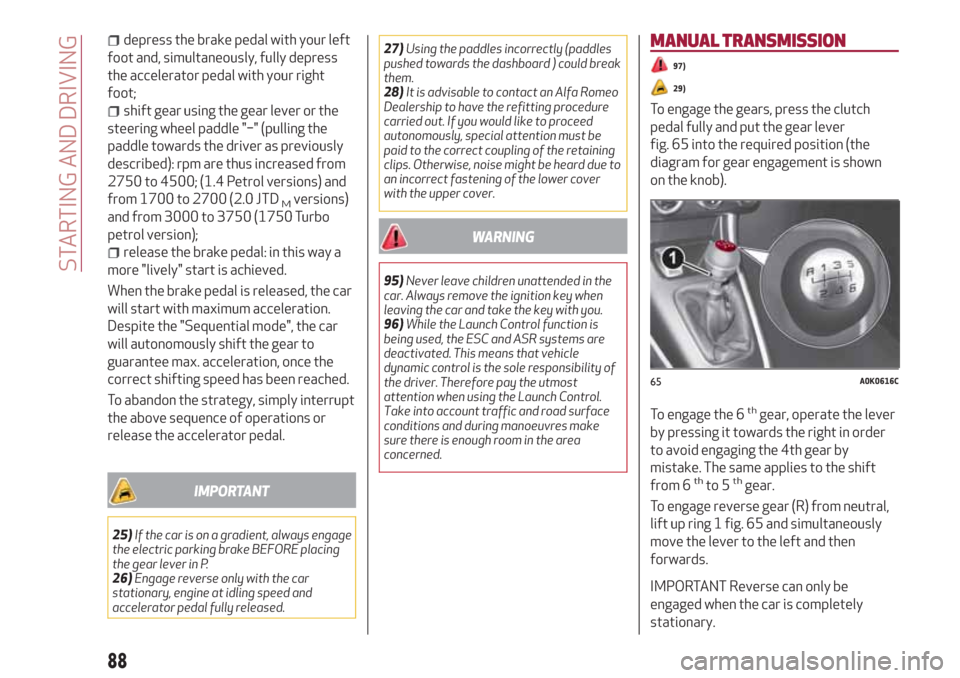
depress the brake pedal with your left
foot and, simultaneously, fully depress
the accelerator pedal with your right
foot;
shift gear using the gear lever or the
steering wheel paddle "−" (pulling the
paddle towards the driver as previously
described): rpm are thus increased from
2750 to 4500; (1.4 Petrol versions) and
from 1700 to 2700 (2.0 JTD
Mversions)
and from 3000 to 3750 (1750 Turbo
petrol version);
release the brake pedal: in this way a
more "lively" start is achieved.
When the brake pedal is released, the car
will start with maximum acceleration.
Despite the "Sequential mode", the car
will autonomously shift the gear to
guarantee max. acceleration, once the
correct shifting speed has been reached.
To abandon the strategy, simply interrupt
the above sequence of operations or
release the accelerator pedal.
IMPORTANT
25)If the car is on a gradient, always engage
the electric parking brake BEFORE placing
the gear lever in P.
26)Engage reverse only with the car
stationary, engine at idling speed and
accelerator pedal fully released.27)Using the paddles incorrectly (paddles
pushed towards the dashboard ) could break
them.
28)It is advisable to contact an Alfa Romeo
Dealership to have the refitting procedure
carried out. If you would like to proceed
autonomously, special attention must be
paid to the correct coupling of the retaining
clips. Otherwise, noise might be heard due to
an incorrect fastening of the lower cover
with the upper cover.
WARNING
95)Never leave children unattended in the
car. Always remove the ignition key when
leaving the car and take the key with you.
96)While the Launch Control function is
being used, the ESC and ASR systems are
deactivated. This means that vehicle
dynamic control is the sole responsibility of
the driver. Therefore pay the utmost
attention when using the Launch Control.
Take into account traffic and road surface
conditions and during manoeuvres make
sure there is enough room in the area
concerned.
MANUAL TRANSMISSION
97)
29)
To engage the gears, press the clutch
pedal fully and put the gear lever
fig. 65 into the required position (the
diagram for gear engagement is shown
on the knob).
To engage the 6
thgear, operate the lever
by pressing it towards the right in order
to avoid engaging the 4th gear by
mistake. The same applies to the shift
from 6
thto 5thgear.
To engage reverse gear (R) from neutral,
lift up ring 1 fig. 65 and simultaneously
move the lever to the left and then
forwards.
IMPORTANT Reverse can only be
engaged when the car is completely
stationary.
65A0K0616C
88
STARTING AND DRIVING
Page 108 of 216
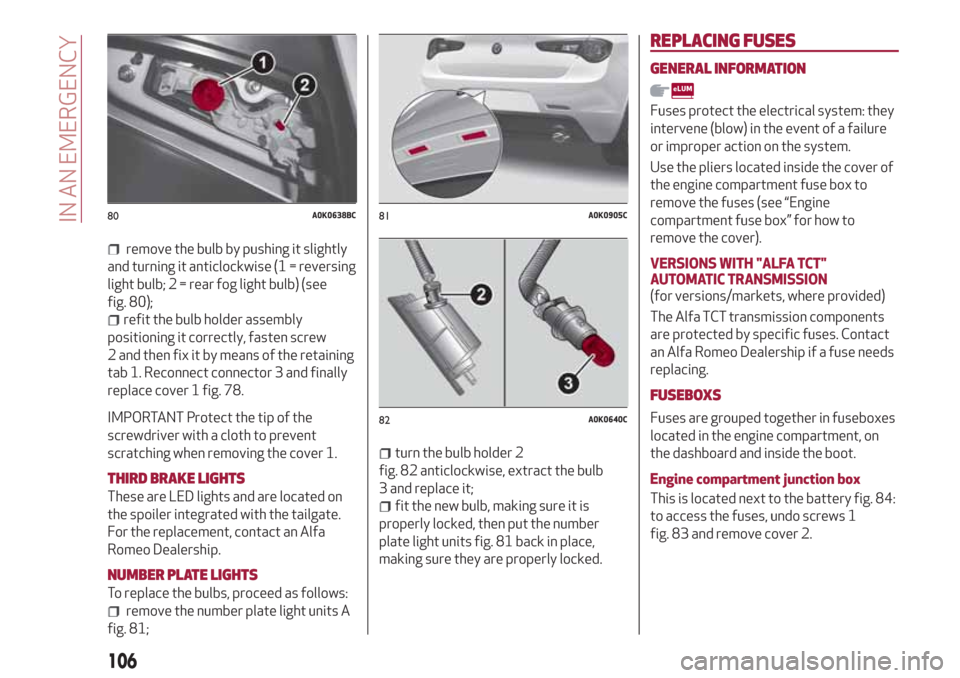
remove the bulb by pushing it slightly
and turning it anticlockwise (1 = reversing
light bulb; 2 = rear fog light bulb) (see
fig. 80);
refit the bulb holder assembly
positioning it correctly, fasten screw
2 and then fix it by means of the retaining
tab 1. Reconnect connector 3 and finally
replace cover 1 fig. 78.
IMPORTANT Protect the tip of the
screwdriver with a cloth to prevent
scratching when removing the cover 1.
THIRD BRAKE LIGHTS
These are LED lights and are located on
the spoiler integrated with the tailgate.
For the replacement, contact an Alfa
Romeo Dealership.
NUMBER PLATE LIGHTS
To replace the bulbs, proceed as follows:
remove the number plate light units A
fig. 81;
turn the bulb holder 2
fig. 82 anticlockwise, extract the bulb
3 and replace it;
fit the new bulb, making sure it is
properly locked, then put the number
plate light units fig. 81 back in place,
making sure they are properly locked.
REPLACING FUSES
GENERAL INFORMATION
Fuses protect the electrical system: they
intervene (blow) in the event of a failure
or improper action on the system.
Use the pliers located inside the cover of
the engine compartment fuse box to
remove the fuses (see “Engine
compartment fuse box” for how to
remove the cover).
VERSIONS WITH "ALFA TCT"
AUTOMATIC TRANSMISSION
(for versions/markets, where provided)
The Alfa TCT transmission components
are protected by specific fuses. Contact
an Alfa Romeo Dealership if a fuse needs
replacing.
FUSEBOXS
Fuses are grouped together in fuseboxes
located in the engine compartment, on
the dashboard and inside the boot.
Engine compartment junction box
This is located next to the battery fig. 84:
to access the fuses, undo screws 1
fig. 83 and remove cover 2.
80A0K0638BC81A0K0905C
82A0K0640C
106
IN AN EMERGENCY
Page 115 of 216
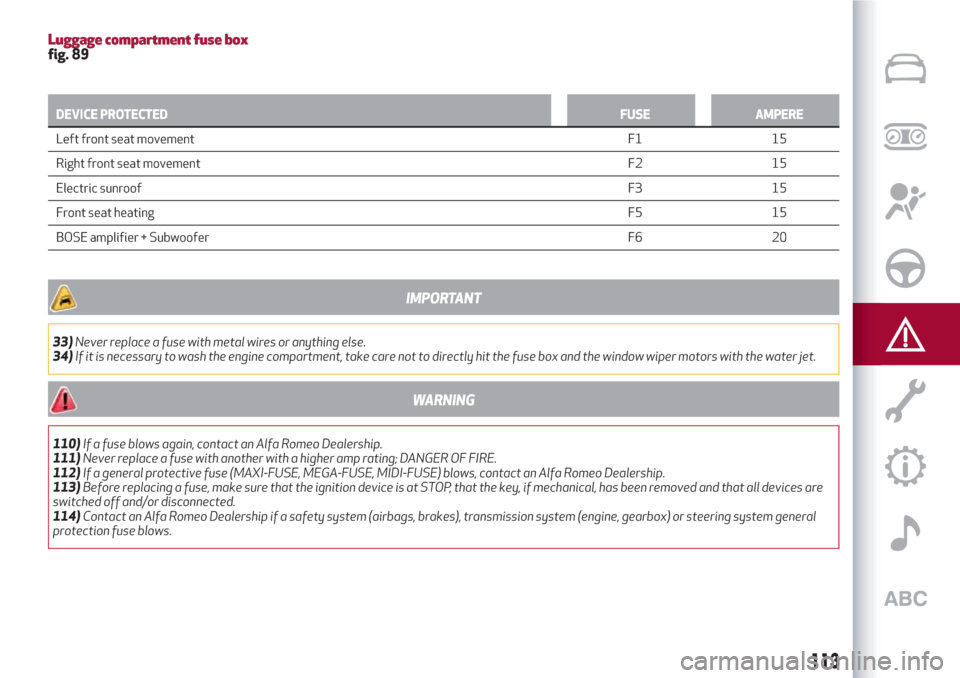
Luggage compartment fuse boxfig. 89
DEVICE PROTECTEDFUSE AMPERE
Left front seat movementF1 15
Right front
seat movementF2 15
Electric sunroofF3 15
Front seat heatingF5 15
BOSE amplifier + SubwooferF6 20
IMPORTANT
33)Never replace a fuse with metal wires or anything else.
34)If it is necessary to wash the engine compartment, take care not to directly hit the fuse box and the window wiper motors with the water jet.
WARNING
110)If a fuse blows again, contact an Alfa Romeo Dealership.
111)Never replace a fuse with another with a higher amp rating; DANGER OF FIRE.
112)If a general protective fuse (MAXI-FUSE, MEGA-FUSE, MIDI-FUSE) blows, contact an Alfa Romeo Dealership.
113)Before replacing a fuse, make sure that the ignition device is at STOP, that the key, if mechanical, has been removed and that all devices are
switched off and/or disconnected.
114)Contact an Alfa Romeo Dealership if a safety system (airbags, brakes), transmission system (engine, gearbox) or steering system general
protection fuse blows.
113
Page 122 of 216

JUMP STARTING
STARTING THE ENGINE
If the iconstays on constantly on the
instrument panel, contact the Alfa
Romeo Dealership immediately.
JUMP STARTING
If the battery is flat, start the engine
using an auxiliary battery with the same
capacity or a little higher than the flat
one.
38) 39)123)
Proceed as follows to start the vehicle:
connect the positive terminal (+)
fig. 104 of the auxiliary battery only to
the point indicated on the car battery
(writing "OK") and nowhere else;
with a second lead, connect the
negative terminal(−)oftheauxiliary
battery to an earthing point
on the
engine or the gearbox/transmission of
the car to be started;
start the engine; when the engine has
been started, remove the leads reversing
the order above.
If after a few attempts the engine does
not start, contact the Alfa Romeo
Dealership.
JUMP STARTING
(For versions with Start&Stop system)
When jump starting, never connect the
negative lead (–) of the auxiliary battery
to the negative pole 1 fig. 105 of the car
battery, but rather to an engine/gearbox
earth point.
124)
BUMP STARTING
Never, under any circumstances, jump
start the engine by pushing, towing or
coasting downhill.
IMPORTANT
38)Never connect the negative terminals of
the two batteries directly! If the auxiliary
battery is installed on another car, prevent
accidental contact between metallic parts of
the two cars.
39)Never use a fast battery-charger to
start the engine as this could damage the
electronic systems of your vehicle,
particularly the ignition and engine fuel
supply control units.
WARNING
123)This starting procedure must be
performed by expert personnel because
incorrect actions could cause electrical
discharge of considerable intensity.
Furthermore, battery fluid is poisonous and
corrosive: avoid contact with skin and eyes.
Keep naked flames and lighted cigarettes
away from the battery and do not cause
sparks.
124)Before opening the bonnet, make sure
that the engine is off and that the ignition
key is in the STOP position. Please follow the
instructions on the decal near the front
crossmember. We recommend that you
remove the key from the ignition if other
people remain in the vehicle. The vehicle
should always be left after the key has been
removed or turned to the STOP position.
During refuelling, make sure that the engine
is off (and that the ignition key is in the STOP
position).
104A0K0247C
105A0K0755C
120
IN AN EMERGENCY
Page 126 of 216

"VELOCE" versions or versions with
"Pack sport": detach plug 1 by pressing
on the upper part, take tow hook 2 from
its housing in the tool support and screw
it in fully on the threaded pin (fig. 117 ).
WARNING
126)For versions with key without remote
control, before towing, turn the ignition key
to MAR and then to STOP without removing
it. The steering column will automatically
lock when the key is removed and the wheels
cannot be steered. Also check that the
gearbox is in neutral (on versions equipped
with automatic transmission, check that the
gear lever is in N position). For versions with
electronic key, move the ignition device to
MAR and then to STOP, without opening the
door.127)The brake servo and the
electromechanical power steering will not
work while the vehicle is being towed. You
will therefore need to apply more force on
the brake pedal and steering wheel. Do not
use flexible ropes when towing, and avoid
jerky movements. During towing, make sure
that the trailer hitch does not damage any
components it is touching. When towing the
car, you must comply with all specific traffic
regulations and adopt an appropriate
driving behaviour. Do not start the engine
while towing the car. Before tightening the
ring, clean the threaded housing thoroughly.
Make sure that the ring is fully screwed into
the housing before towing the car.
128)The front and rear tow hooks should be
used only for emergencies on the road. You
are allowed to tow the vehicle for short
distances using an appropriate device in
accordance with the highway code (a rigid
bar), to move the vehicle on the road in
readiness for towing or transport via a
breakdown vehicle. Tow hooks MUST NOT be
used to tow vehicles off the road or where
there are obstacles and/or for towing
operations using cables or other non-rigid
devices. In compliance with the above
conditions, towing must take place with the
two vehicles (one towing, the other towed)
aligned as much as possible along the same
centre line.
117A0K0898C
124
IN AN EMERGENCY